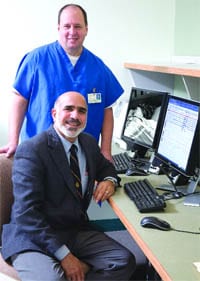Seeing the Light Eye Surgery Has Come a Long Way Since LASIK
Ten years ago, if there had been one field of medicine that didn’t seem a likely candidate to generate some of the most impressive news of the coming decade, eye care might have been it.
That’s because ophthalmology was one of the stars of the 1990s, due the groundbreaking procedure known as LASIK, that uses lasers to repair vision long-term. That development, now just over 15 years old, generated plenty of headlines and continues to create satisfied customers.
But, rather than rest on its laurels, ophthalmology has, if anything, topped LASIK with a string of advances that more than earns a featured place in the Healthcare News’ decade in review.
Take cataract surgery, for example.
“Ten years ago, patients almost inevitably required glasses following a cataract procedure, whether it was from astygmatism or the need to read,” said Dr. John Frangie, who heads Northeast Laser Center in West Springfield. “Now, with cataract surgery, we have the ability to have patients free of glasses 85{06cf2b9696b159f874511d23dbc893eb1ac83014175ed30550cfff22781411e5} to 95{06cf2b9696b159f874511d23dbc893eb1ac83014175ed30550cfff22781411e5} of the time, including when reading, using the computer, and driving, due to these advanced technologies.”
In addition, the cataract procedure now in wide use is much less traumatic for patients than it was 20 years ago. Today, implants are made of a material that can be folded and slid through a small incision, and the whole procedure is done on an outpatient basis. In the past, doctors had to make a cut the size of the lens itself, and patients would be hospitalized for days.
That advance, along with the more recent improvements in vision after the procedure, have made cataract surgery not just easier on the patient, but a way to turn back the clock on his or her vision — not just to before cataracts, but before glasses or contacts.
Frangie said it’s gratifying to work in a field that offers that kind of sudden life change for patients. “That’s fun,” he told The Healthcare News. “I’m blessed.”
Not as blessed, however, as patients with vision problems who now have more — and more effective — options than ever before.
Vision Quest
Dr. Kevin Hulseberg, an ophthalmologist with Pioneer Valley Eye Associates in Holyoke, recalls cataract surgery before the advent of no-stitch techniques. “Ten or 15 years ago, people made incisions that went from 10 o’clock to 2 o’clock; half the eye got opened up to get the lens out and put an artificial lens in.”
That meant slower recovery and more chance of infection, contrasted with today’s smaller incisions. And engineers continue to hone the process. “Faster computers make it safer for the inside of the eye,” he said. “They actually monitor the pressure in the eye and respond in milliseconds, so there’s less chance of damaging the interior of the eye during cataract surgery.”
As a result, today, artificial lens implants are not only minimally invasive, and take literally decades off long-term sight deterioration, they’re also safer.
“Right now there are a few varieties of intraocular contact lens,” Hulseberg. But in all cases, “basically, instead of cutting the cornea and thinning it out using optical materials to change the light rays, we’re basically putting miniature contact lenses inside the eye that are safe and biocompatible, so the structural integrity of the eye is maintained.”
The options are plentiful, too. “Multifocal lenses help people see far away and up close, and they’re being utilized more and more,” he explained. “They’re in their third generation, so we’re trying to get away from some of the aberrations and light distortions that the earlier models had.”
“One of the more exciting ones is the Synchrony lens,” Hulseberg said. “It’s actually two lenses separated by a pliable strut so that your own ciliary muscle moves it, the same as a telescope, in and out, close and distant, without having to rely on a multifocal lens.” The technology has been approved in Europe, but still awaits approval by the U.S. Food and Drug Administration.
Even LASIK is more advanced and precise than it used to be, said Frangie, who considers it part of a continuum of new techniques that are cutting-edge, minus the cutting.
“We now have the ability to customize patient treatment for all ages,” Frangie said, not just the older patients benefiting from what he called a “sea change” in cataract care. “In the younger age group, we have laser vision correction. The more advanced centers no longer use blades, and we’re able to customize treatment to each and every patient — and each eye of each individual patient — so the results are clearer vision, quicker rehabilitation … in short, better outcomes.”
And new techniques to improve vision continue to emerge. Dr. Alfred Hutt, who owns Hutt Eye Associates in Holyoke, says he’s the only ophthalmologist in the area performing a procedure called orthokeratology, which employs a specially designed contact lens that is worn only at night, during sleep, and removed in the morning.
“The eye is reshaped overnight so you don’t have to wear glasses or contact lenses during the day,” Hutt explained. “It’s not permanent; you have to put it in every night — although, after a while, the eye might stay in shape for a few days. But this is wonderful for people who are tired of contact lenses or have come in with bad reactions to contact lenses.”
The procedure has only been approved for use since 2004, so much of its results are anecdotal, Hutt said, but in kids, “it’s the only thing that’s been reliable in holding back the progression of nearsightedness, so that’s really fantastic.” He added that the technique is beneficial for young athletes in sports like hockey and football who don’t have to worry about a contact lens slipping, and it eases parents’ concerns about kids’ hygiene at school and the potential to develop infection in the lens.
Back to Living
Other developments are simpler, such as those involving new drugs.
“Ten years ago, we were using a hot laser to treat macular degeneration,” Hutt said. “With the advent of a couple of medications, Lucentis and Avastin, we’re shrinking the new blood vessels that form during wet macular degeneration, but we don’t destroy the healthy retinal tissues. We had to do that with the laser; we had to destroy some of the good to get to the bad.”
These advances and others will become even more important among an aging population of Baby Boomers who have always been active and want to remain so.
“For the first time in their lives, so many patients have the ability to see without correction for golfing, tennis, and whatever else,” Frangie told the Healthcare News. “This has a lot of significance for our more active retirees.”
And younger people, for that matter.
“My daughter went to Greece right after her interocular lens inplant,” Hulseberg said. “She was jumping off the cliffs and plunging into the water.”
As awareness grows of what today’s eye surgeons have to offer, it’s a sure bet that many more Americans will take the plunge — and open their eyes to a new world.




Comments are closed.